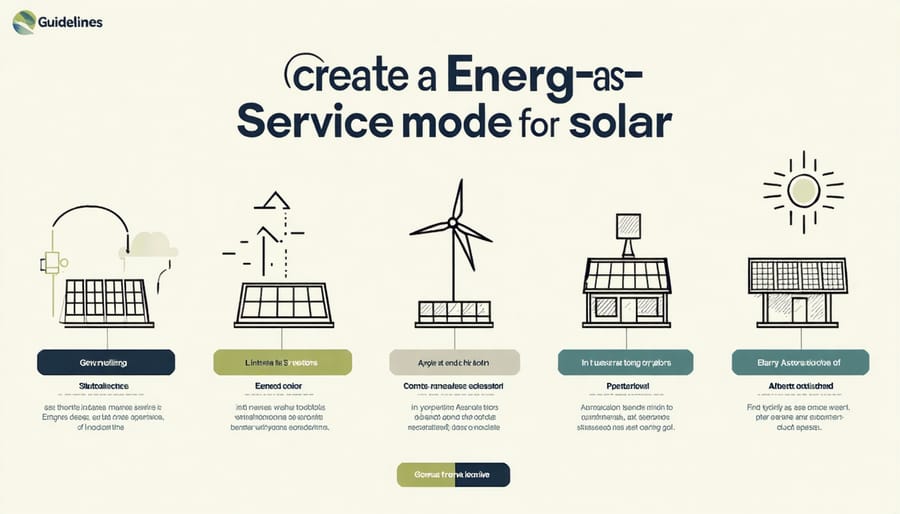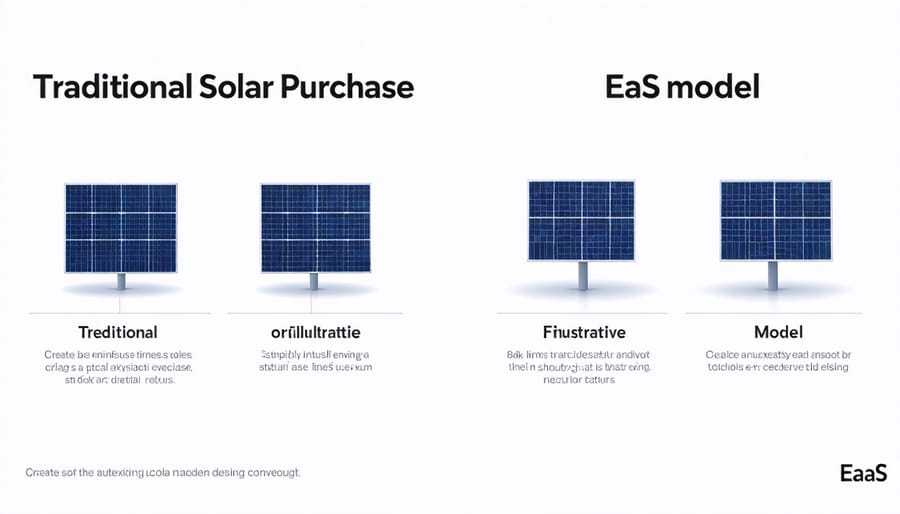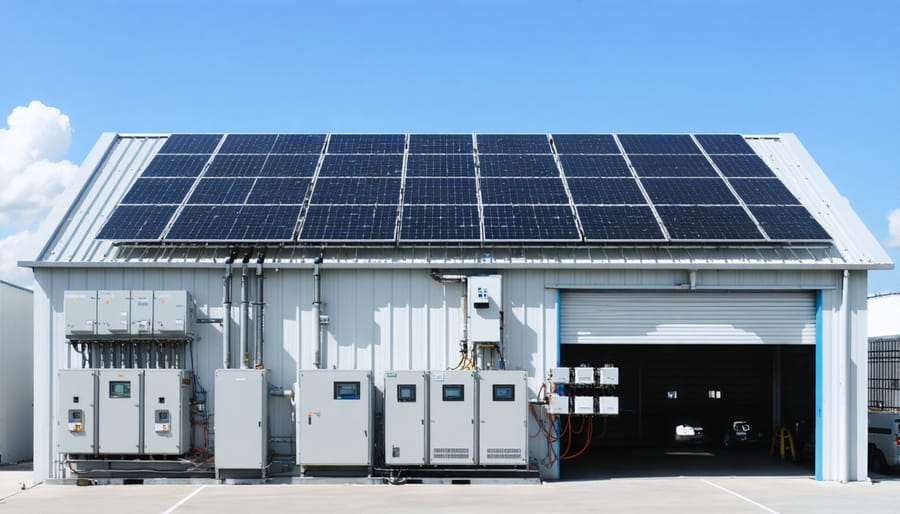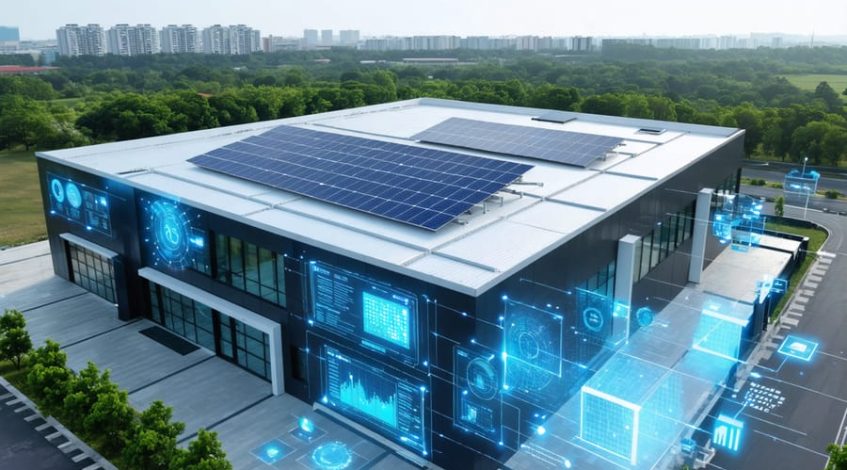Transform your energy costs into a predictable operational expense through Energy-as-a-Service (EaaS), an emerging model that’s revolutionizing how businesses consume and manage power. By leveraging innovative solar business models, organizations can now access renewable energy solutions without substantial capital investment or technical expertise.
The EaaS model represents a paradigm shift in energy management, where providers assume full responsibility for system design, installation, maintenance, and performance monitoring. This comprehensive approach enables businesses to focus on their core operations while achieving sustainability goals and reducing operational costs. Leading corporations have reported 20-30% reduction in energy expenses within the first year of EaaS implementation, while maintaining zero upfront costs.
As market volatility and environmental regulations intensify, EaaS offers a strategic advantage by providing fixed-rate energy contracts, guaranteed performance metrics, and professional system optimization. This innovative approach aligns perfectly with both immediate cost-reduction objectives and long-term sustainability goals, making it an increasingly attractive option for forward-thinking organizations seeking to modernize their energy infrastructure.
What is Energy-as-a-Service in Solar?
Key Components of Solar EaaS
Solar Energy as a Service comprises several interconnected components that work together to deliver a comprehensive energy solution. The installation process begins with a thorough site assessment and system design, followed by professional deployment of solar panels, inverters, and monitoring equipment. All hardware costs are covered within the service agreement, eliminating the need for upfront capital investment.
Ongoing maintenance forms a crucial component, with providers handling all routine inspections, repairs, and equipment replacements throughout the contract period. Advanced monitoring systems track system performance in real-time, enabling predictive maintenance and optimal energy production. Many providers offer performance guarantees, ensuring specified energy output levels.
The financial structure typically involves a power purchase agreement (PPA) or subscription-based model, where clients pay for the energy consumed at a predetermined rate. This rate is often lower than traditional utility costs and can be fixed or include modest escalators. The service provider maintains ownership of the system, assuming all operational risks and responsibilities.
Additional components may include energy storage solutions, grid integration services, and detailed performance reporting. Some providers also offer supplementary services such as demand response program participation and carbon offset tracking.

How It Differs from Traditional Solar Purchasing
The Energy as a Service (EaaS) model represents a significant departure from traditional solar purchasing methods. While conventional solar acquisition requires substantial upfront capital investment, often ranging from hundreds of thousands to millions of dollars, EaaS eliminates these initial costs entirely. Instead, customers pay a predictable monthly fee for their energy consumption.
Traditional solar purchasing also places the burden of system maintenance, monitoring, and performance optimization on the property owner. These responsibilities require technical expertise and ongoing operational oversight. In contrast, EaaS providers assume full responsibility for system performance, maintenance, and upgrades, ensuring optimal energy production throughout the contract term.
Another key distinction lies in risk allocation. Conventional solar purchases expose owners to various risks, including equipment failure, performance degradation, and technological obsolescence. The EaaS model transfers these risks to the service provider, who is incentivized to maintain peak system performance to meet contractual obligations.
Furthermore, traditional solar investments typically require long-term ownership commitments, while EaaS offers greater flexibility through customizable contract terms and the ability to scale energy services based on changing business needs.

Financial Benefits for Businesses
Zero Upfront Investment
One of the most compelling aspects of the Energy as a Service (EaaS) model is its elimination of upfront capital requirements. Traditional energy infrastructure upgrades often demand substantial initial investments, creating a significant barrier for many organizations. With EaaS, businesses can implement comprehensive energy solutions without any upfront costs, as service providers assume all capital expenditure responsibilities.
Under this model, organizations can immediately maximize solar energy profits while preserving their capital for core business operations. The service provider handles all aspects of the energy system installation, maintenance, and optimization, converting what would typically be a large capital expense into predictable operational costs.
This zero-investment approach particularly benefits organizations with limited capital resources or those preferring to allocate their funds to other strategic initiatives. The model also reduces financial risk, as payments are typically tied to system performance and energy savings, ensuring that organizations only pay for the value they receive. This alignment of interests between service providers and clients creates a sustainable partnership focused on optimal energy system performance and cost reduction.
Predictable Energy Costs
One of the most compelling advantages of the Energy-as-a-Service (EaaS) model is its ability to deliver predictable energy costs over extended periods. Unlike traditional energy procurement methods, which leave organizations vulnerable to market fluctuations and unexpected price spikes, EaaS arrangements typically feature fixed-rate agreements that provide budget certainty and improved financial planning capabilities.
These fixed-rate contracts often span 10-15 years, allowing organizations to accurately forecast their energy expenses and protect themselves against volatile energy markets. As businesses transition toward next-generation energy markets, this predictability becomes increasingly valuable for long-term financial planning and risk management.
The cost predictability extends beyond simple utility rates. EaaS providers typically assume responsibility for maintenance, equipment upgrades, and system optimization, incorporating these expenses into the fixed monthly fee. This comprehensive approach eliminates unexpected maintenance costs and ensures optimal system performance throughout the contract term.
Analysis of existing EaaS implementations shows that organizations can achieve cost savings of 15-25% compared to traditional energy procurement methods. These savings stem from multiple factors, including reduced peak demand charges, optimal system sizing, and the provider’s expertise in energy management. The fixed-rate structure also enables organizations to better leverage their energy costs as a competitive advantage, as they can confidently bid on long-term contracts knowing their energy expenses will remain stable.
Risk Mitigation and Performance Guarantees
Performance Monitoring and Maintenance
Performance monitoring and maintenance form the backbone of successful Energy-as-a-Service implementations. Service providers employ advanced monitoring systems that track energy consumption patterns, system performance, and equipment health in real-time. This continuous oversight enables predictive maintenance, helping prevent system failures before they occur and ensuring optimal energy efficiency.
Providers typically utilize sophisticated analytics platforms to gather and analyze performance data, generating detailed reports that showcase energy savings, carbon reduction, and system efficiency metrics. These insights allow for data-driven decisions about system optimization and necessary upgrades.
The maintenance component includes regular equipment inspections, cleaning, repairs, and component replacements when needed. Service providers maintain dedicated technical teams that respond quickly to any system issues, minimizing downtime and maintaining consistent energy delivery. This proactive approach helps maintain peak system performance and extends equipment lifespan.
Additionally, many providers offer customer portals where clients can monitor their energy consumption, track savings, and access performance reports. This transparency helps organizations validate their ROI and make informed decisions about their energy management strategies.

Provider Accountability
Provider accountability in Energy-as-a-Service models is primarily governed through comprehensive Service Level Agreements (SLAs) that establish clear performance metrics and guarantees. These legally binding agreements typically outline specific energy efficiency targets, system uptime requirements, and response times for maintenance and repairs.
Most EaaS providers offer performance guarantees that ensure predetermined levels of energy savings or system performance. If these benchmarks aren’t met, providers may be required to compensate clients through predetermined financial mechanisms or service credits. Common guarantees include minimum energy production levels for renewable systems, maximum response times for technical support, and specific cost-saving targets.
Key accountability measures often include:
– Monthly performance reporting and analytics
– Regular system monitoring and preventive maintenance
– Guaranteed response times for system issues
– Financial compensation for missed performance targets
– Annual system optimization reviews
These accountability structures shift operational risks from customers to service providers, ensuring that EaaS providers remain invested in maintaining optimal system performance throughout the contract term. This alignment of interests helps create a sustainable partnership focused on achieving long-term energy efficiency goals and cost savings.
Implementation Process
The implementation of Solar Energy as a Service follows a structured five-step process designed to ensure seamless adoption and maximum value for organizations. Initially, the service provider conducts a comprehensive site assessment and energy audit to evaluate the facility’s current energy consumption patterns, structural requirements, and solar potential.
Following the assessment, the provider develops a customized solution that includes system design, equipment specifications, and projected energy production estimates. This phase also involves detailed financial modeling to demonstrate expected cost savings and ROI calculations, helping stakeholders make informed decisions.
The third step encompasses contract negotiation and agreement finalization. Key terms typically include performance guarantees, maintenance responsibilities, monitoring protocols, and payment structures. Organizations should review these agreements carefully with legal counsel to ensure their interests are protected.
Implementation begins with system installation and integration. The service provider manages all aspects of construction, including permits, equipment procurement, and utility interconnection. This phase usually takes 2-3 months, depending on system size and complexity. Throughout installation, providers work to minimize disruption to regular business operations.
The final phase involves system commissioning and ongoing operations. The provider establishes remote monitoring systems to track performance and energy production in real-time. Regular maintenance schedules are implemented, and detailed performance reports are provided to stakeholders. This ensures the system continues to deliver optimal results throughout the contract term.
Success metrics are established and monitored throughout the process, including energy production targets, cost savings, and environmental impact measurements. Regular reviews help identify opportunities for optimization and ensure the system meets agreed-upon performance standards.
Real-World Success Stories
Several leading organizations have successfully implemented the Solar Energy-as-a-Service model, demonstrating its viability and benefits. Walmart, for instance, partnered with SunPower to deploy solar installations across 360 stores, reducing energy costs by approximately 25% without any upfront investment. The retailer now enjoys predictable energy expenses while advancing its sustainability goals.
Target Corporation adopted a similar approach in 2019, implementing EaaS solutions across 500 locations. This initiative resulted in annual energy savings of $30 million and reduced their carbon footprint by 50,000 metric tons. The success prompted Target to expand the program to additional facilities.
In the manufacturing sector, BMW’s Spartanburg facility showcases how EaaS can transform industrial operations. Through a comprehensive solar EaaS agreement, the plant now sources 40% of its energy from renewable sources, while maintaining stable energy costs for a 20-year term. The facility has even begun exploring peer-to-peer energy trading opportunities with neighboring businesses.
Small and medium-sized enterprises have also achieved remarkable results. The Plaza Hotel in New York implemented a solar EaaS solution that reduced their energy expenses by 35% in the first year, while maintaining their historic building’s aesthetic integrity. Similarly, Central Valley School District in Pennsylvania deployed solar arrays across six schools through an EaaS model, projecting $5 million in savings over 25 years while providing students with hands-on learning opportunities in renewable energy.
Solar Energy as a Service represents a transformative approach to energy management that enables businesses to embrace sustainable practices while maintaining financial flexibility. By eliminating substantial upfront costs and shifting technical responsibilities to experienced providers, organizations can focus on their core operations while enjoying the benefits of clean, reliable energy.
The key advantages of Solar EaaS are compelling: immediate cost savings, predictable energy expenses, reduced operational risks, and enhanced environmental credentials. Organizations can achieve their sustainability goals without compromising their capital resources or taking on technical complexities. The model’s pay-as-you-go structure aligns perfectly with modern business needs for flexibility and scalability.
For businesses considering Solar EaaS adoption, the time to act is now. Energy markets continue to evolve, and early adopters stand to gain significant competitive advantages. We recommend taking these initial steps:
1. Assess your current energy consumption patterns and costs
2. Engage with reputable EaaS providers for site evaluation
3. Review proposed solutions and financial models
4. Evaluate potential environmental impact and ROI
5. Develop a timeline for implementation
As global energy demands increase and environmental regulations tighten, Solar EaaS offers a practical pathway to future-proof your organization’s energy strategy. By partnering with experienced providers, businesses can accelerate their transition to renewable energy while maintaining focus on growth and innovation. Take the first step toward energy independence and sustainability by exploring Solar EaaS solutions for your organization today.

